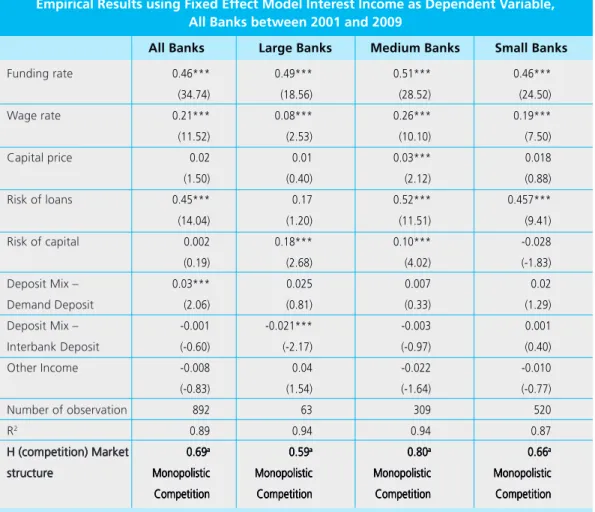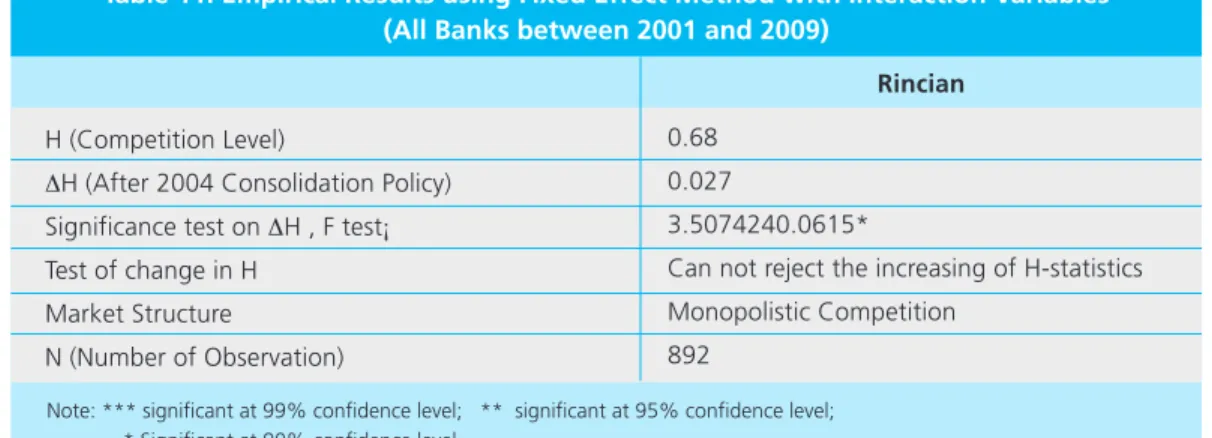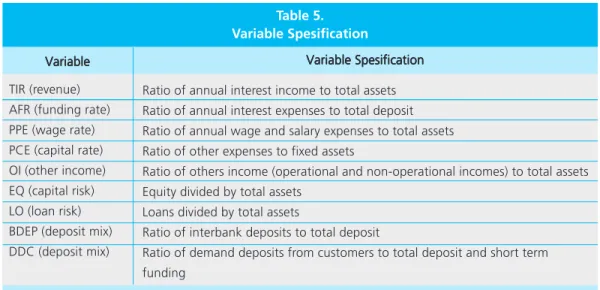The change in market structure was promoted by deregulation policies in the banking sector in the 1980s. The banking architecture will guide the development of the Indonesian banking system over the next ten years. We suspect that at least two policies under the Indonesian banking architecture will directly affect market structure and competition in the banking sector.
The study aims to assess the impact of consolidation policies in the banking industry on the market situation. Referring to Table 3, a large number of mergers and acquisitions took place in the Indonesian banking industry between 1997 and 2010. The causal relationship becomes unclear because firms' decision to enter the market may be influenced by expectations of the degree of competition in the scene. of the market (Vesalla, 1995, p. 18).
3 Panzer, J.C., Rose, J.N., (1987) developed a measure to assess market competition by observing the behavior of banks. Many studies applied the Panzar-Rose (PR) method to measure the impact of consolidation policies on competition in the banking sector. Shaffer (1982), Molyneux et al (1994), Bikker and Haaf (2002) and Bandt and Davis (2000) examined the impact of bank consolidation in the United States and European countries on competition.
Molyneux et al (1994) attempted to assess the impact of consolidation on competition at an early stage of the implementation of the single market policy.
METHODOLOGY 3.1. Empirical Model
Data
It consists of the unconsolidated annual balance sheets and income statements of the commercial banks. The annual variation on the number of banks is caused by mergers, acquisitions, bank liquidations and bank entry during the observation period. In the case of mergers and acquisitions, the database only holds the data of the new institution, which is usually the larger bank.
Currently, Indonesia has 4 state-owned banks, 68 local private banks, which consist of banks that deal with foreign exchange services and those that do not. The shareholders of regional banks are the provincial government and municipalities. Compared to other developing countries in Southeast Asia, the number of banks in Indonesia is large.
Bank balance sheets show that, on average, 3 out of 113 banks control more than forty percent of the industry between 2001 and 2009. Descriptive statistical information on the distribution of assets and capital supports the idea of a highly concentrated market. Type of banks (based on categorization of central banks) Type of banks (based on categorization of central banks) Type of banks (based on categorization of central banks) Type of banks (based on categorization of central banks).
Bank type (based on central bank categorization) Number of banksNumber of banksNumber of banksNumber of banksNumber of banks. Referring to the data, half of the bank (56 banks) had an equity capital of less than 550 billion rupiah. On the other hand, a very small part of the banks - less than 1 percent or only 7 banks - have an equity capital of more than DKK 10 billion.
Dividing the sample into large, medium and small banks is important to capture the real behavior of banks in competition with other banks in their categories. The value of capital in 2009 will be used as a basis for dividing the sample into large, medium and small banks. In terms of the number of banks, the category of small banks dominates the market; however the market is controlled by the largest group.
RESULT AND ANALYSIS
Competition in Banking Industry
They confirm that the fixed effect model is more reliable and captures the information about what contributes to the difference across banks. The model can thus capture the information about what contributes to the differences across banks. The F-test shows that the value is significantly different from zero, thus rejecting the monopoly hypotheses.
It is also significantly different from one, so it also rejects the hypotheses of perfect competition. Empirical results using fixed effect model interest income as dependent variable, all banks between 2001 and 2009. Funding rate Pay rate Price of capital Credit risk Equity risk Deposits Mix √ Demand deposits Mix of deposits √ Interbank deposits Other income Number of observations.
All banks Large banks Medium banks Small banks .. a) the value of the F test shows that H is not significantly different from 0 and 1 (99% confidence level). The value in parentheses is the t-statistic;. The H-statistic varies from 0.59 to 0.80, indicating that the banking market in all groups operated under monopolistic competition. The H-statistic for the group of medium-sized banks is quite high (0.80) and is comparable to the banking market in developed countries and other emerging markets such as Latin American banks (Yeyati and Micco, 2007).
This is quite surprising as in other countries including Europe; the banking market of larger banks is more competitive than that of smaller banks, which usually service the local market (Bikker and Haaf, 2002). The sign of the coefficients is also positive, which means that the increase in the wage rate is transferred to income. Positive coefficients for loan risk mean that banks with a higher proportion of loans on their balance sheets generate higher interest income per rupee of assets.
For the larger banks, it can therefore be concluded that the higher share of equity per asset generates higher income. The deposit mix variables are not really significant in explaining the movement in earnings, except for the share of interbank deposits in total deposits in the major banking market. The sign of the coefficient is negative, which means that the greater the share of interbank deposits in total deposits, the less income can be earned.

Market Structure and Competition
Unlike developed countries where consolidation has increased market concentration7, policy changes are reducing concentration in the Indonesian banking market. While in developed countries and in the more mature emerging markets of Latin America, mergers and acquisitions have been market-driven. This means that consolidation in the Indonesian banking market does not create more concentrated markets, but improves the distribution of market share.
In the case of large banks, the Single Presence Policy effectively reduced concentration through the consolidation of PT Bank Niaga Tbk. This merger significantly reduced market concentration because the new merging bank was not in the top three major banks. The mergers and acquisitions in the medium-sized and small banking market aimed to improve the banks' performance after the economic crisis of 1997 or to comply with the policy on single presence or minimum capital requirements.
They have a better market share distribution, as the three largest banks in the group only controlled less than 35 percent of the market share. However, if we compare the value of the concentration changes, the changes in the level of concentration in medium-sized banks and small banks were relatively smaller, especially if we refer to the Herfindahl-Hirschman index. The information on market concentration and competition in the medium-sized banks and small banks helps to understand this phenomenon.
The markets for medium and small banks were highly competitive and less concentrated, therefore the mergers and acquisitions only slightly reduced market concentration. On the other hand, the market for medium-sized banks is the most competitive because it is less concentrated (CR3average=0.26; HHI average =0.05). Small banks also operate in a fairly competitive environment because each bank has a small share of the total market (CR3average=0.31; HHI average =0.05).
The result confirms that the consolidation policies increased competition in the Indonesian banking sector. It significantly increased the finances of the merging banks and equipped them with greater capacity to compete with other banks. The improvement in the distribution of market shares reduced market concentration and increased competition.

CONCLUSION
The increased economies of scale of the merged banks and the improved distribution of market share increased competition. This is probably why big banks in Indonesia are working in a less competitive market than smaller banks.
How does foreign entry affect the domestic banking market.Policy Research Working Paper.The World Bank. Proceedings of a Conference on Banking Structure and Competition (Federal Reserve Banks of Chicago) in May. Alternative specification, empirical results Polled regression model for fixed effect method, total revenue as dependent variable (all banks between 2001 and 2009).
Capital risk Deposit mix - Demand deposit Deposit mix - Interbank deposit Other income Number of observations. Empirical Results of Polled Regression Model of Fixed Effect with Time Dummies All Banks between 2001 and 2009.
